This is a series of blogs based on my own personal game collection. I will attempt to go through them in a chronological order according to their release date. I will also attempt to play then on their original platform using the original controllers the game was designed for. If I am unable to get the system or the game working then I will use PC emulation or another platform emulation like the Intellivision Lives! game for the gamecube
Previous entries
| 5. Microvision's Baseball (1980) 6. Atari 2600's RealSports Baseball (1982) |
Baseball for Nintendo Entertainment System (1983)
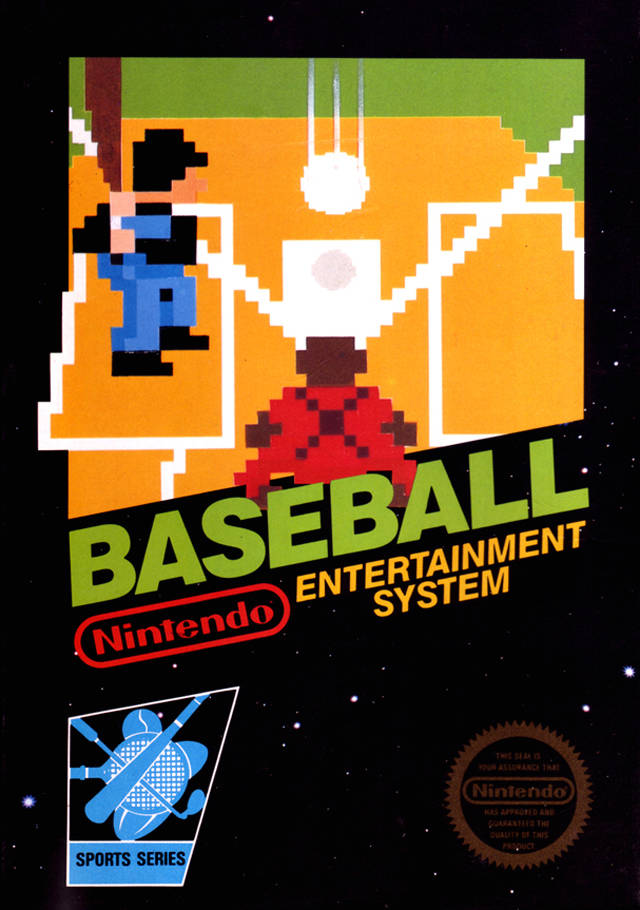
I should probably start this entry by pointing out that 1983 is the one of the first years that gamers receive multiple baseball games at the same time. It seems like every system had a new baseball game. In my personal opinion I don't think it was Atari's E.T that lead to the video game crash of 1983,but the fact there were too many baseball games. With release dates not being 100% accurate back then, It is hard to say which game advanced an aspect of the game first. I don't have all these baseball games, so they won't all be part of these blog series.I have done far amount of research on all of them, I just can't write about the game until I actually play them.
This entry is going in depth with Baseball for the NES. Even though the US didn't get the game until 1985, I am considering it a 1983 game because that is when the international gaming community could play it. Other baseball games in 1983 include Intellivision's World Series Baseball, Realsports Baseball for Atari 2600, 5200 and 7800, Colecovision's first baseball game, Super Action Baseball and the first baseball management game, Micro League Baseball for the C64.
Back to the game at hand, I cleaned my Baseball cartridge, blew the dust off the connectors and turned on my NES system that I always manage to have near my TV since I was a kid. My RF adapter I have been using for the previous games is not in the best shape so I was glad to plug in my composite cables into the NES and get a cleaner look. Baseball never looked so bright.
Graphics
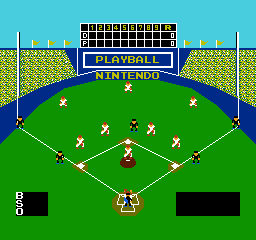
This game advances the graphics of a baseball game by at least double. It laid the ground work for majority of the future games. We see umpires signaling the plays, baseball uniforms, team names, crowds and different camera angles during the game. This is the first time we see a full scoreboard with a summary of scores per inning as well as the overall total. The current inning and batter's count are basic but readable. It uses a baseball icon to display the counts and the tally of balls, strikes and outs. On the bottom right displays the umpires call; "Ball", "Strike", "Out" and "Safe". I find the text very easy to read for a couple reasons. The box where the text is displayed has a black background, which makes the white text stand out and more defined. Previous baseball games, the text were displayed directly on the green field and the colors tended to blur. Also the use of icons helped liven up boring text.
Players
A baseball game with uniforms? This game has it all. The players from a graphic standpoint are improved. Each fielder, batter, pitcher has more than one color. Each team appears to have two assigned colors to them. Yes I said teams. First baseball game to put the power of selecting a team in the hands of the gamer. From a game play prospective there doesn't appear to be any difference between the teams. There is no sense of player roster, all batters look the same, the only difference between the various teams is what two colors make up their uniform. The animation of the batter and pitcher is where majority of the work was done. When the pitcher winds up you can actually see him calling off certain pitches, you get a sense like he agrees or disagrees with your pitch selection directly. The batter takes a full swing and you can move the batter around in the batter's box. The fielders on the other hand are sort of dull. Sure they have various poses for certain actions. We have the hand in the air to catch the ball for an out, we have the throwing pose to the various bases, but it just seems dull. It might be due to the slow nature of the game play but they don't seem to run very fast out there in the outfield.
Field
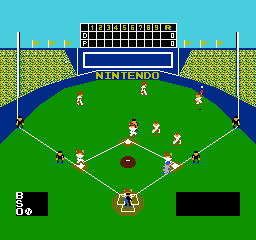
Each entry of this blog series we continue to see more and more baseball elements being incorporated into the game. Intellivision's Major League Baseball incorporated outfield walls (which were weirdly invisible). After Astrocade's Tornado Baseball, foul lines and the correct shape of the bases and home plate are now considered par for the course. Additional element of the sport that makes it's introduction into the video game world is the batter's box. The batter's box is not just a graphical element but also improved the game play and gave the gamer more offensive control. We can now move the batter anywhere within the batter's box. My style of game play I move my batter to the top and slightly away from the plate, I feel I have better contact with the ball that way. Along with the field improvements we are also beginning to witness the formation of a ball park around the playing field. We have a ball park scoreboard, pennants waving in the wind at the top of the stadium as well as foul poles extending the foul lines painted on the field itself. I just want to also point out a standard rule in terms of actual baseball outfield walls. An an outfield wall is not complete unless it contains an advertisement. Thankfully Nintendo knew this and decided to add their name on the wall for advertisement.
Fans
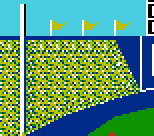
Usually the speed of light is faster than sound but in terms of baseball crowds, it's just the opposite. We heard the roar of the crowd in games like Tornado Baseball and Major League Baseball for the Intellivision in the late 1970's but were never able to witness them. This game introduces us to graphical sports’ crowd. To be honest, there isn't much to see, it is just a pattern of different color dots. This pattern would only be slightly more advanced in the later years and personally feel they actually don't get much better. This aspect of the baseball video game will always lack in terms of quality.
Home Run Celebration
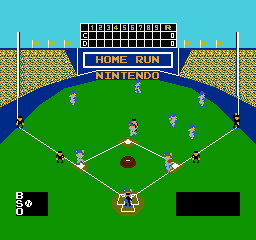
With the innovation of fans and visible crowds in the park, it is only natural that they are used for the home run celebrations. As you view the ball fly high into the seats. The crowd rotates between many different colors given it a strobe light effect to it. As well as the scoreboard flash the words 'HOME RUN'. This game also includes it's own melody for home runs. What I enjoy about these home runs is the buildup. Because the game play is so slow, it takes the ball a good 3 seconds to reach the stands, you see it going, going gone almost in slow motion. You can look at the field and the outfielder continues to run against the wall with their glove out just in case.
Camera/Screen
I briefly mentioned it before but this game is one the first to utilize multiple camera angles for game play. When the pitcher is pitching, the game displays a zoomed in look in the infield. When the ball travels out from this view, the game switches to a more zoomed out look where you can view the entire outfield as well as all this bases. Up until this point, all baseball games only had this view. This provided a more detailed, smoother look during the pitch. Both views displayed the count and the umpire call. The infield view displayed the current score and inning indicator; outfield view displayed the full scoring summary per inning. This game also added an element of ground balls and balls travelling in the air. As the ball traveled higher in the air, the shape of the ball grew and created a shadow on the ground. The shadow helped the gamer know where the ball is travelling and will land and the size of the ball helped the gamer know the vertical distance and therefore time until it comes back to earth.
| Outfield View | Infield view |
|---|---|
 | 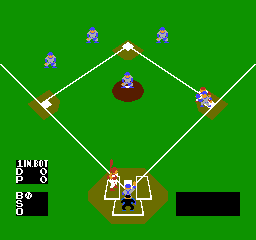 |
Sound
The sound was just OK. The title screen had a little melody but this melody was recycled from previous Nintendo sports games of the time. Home runs had their own melody and each time the ball traveled it created a slide whistle effect. There was no background music so overall the game was on the quiet side of things.
Gameplay - Modes
There is only two modes. one player single game or two player single game. After the game ends, press the reset button and do it all again.
Gameplay - Defense
The graphics are a step in the right direction but the overall game play takes one step back. Overall the game is just slow. It takes forever to pitch the ball after you selected the pitch and the fielding is really bad and slow. For pitching using the d-pad you select the type of pitch, 'Up' for change up, 'Down' for fast ball'...etc and you press the A button to pitch. The pitchers animation is slow and after awhile I found myself attempting to speed it up by pressing the A button many times. Once the ball is in the air is where the game play really slows down. If the ball lands a couple inches away from the closest fielder, good luck trying to avoid a triple or inside the park home run. The gamer has zero control of the fielding besides telling it where to throw it after it retrieves the ball. The CPU fielders seem to be in a better position. The collision detection is really bad as well. Most games if the baseball touches any part of the fielder, they consider the ball to be caught. In this game you can stand right over the ball on the ground and it doesn't pick it up; the ball has to be directly in the center of the fielder. Once the fielder does have the ball, using the d-pad you select the base and able to throw the ball to that base. The problem I have with the throwing animation is the fact that the ball travels the same speed for every throw. If the center fielder throws to home, you might as well use this time for a bathroom break because it is going to be awhile.
Gameplay - Offense
The biggest game play improvement in the offense is the ability to move your batter within the batter's box. Using the d-pad prior and during the pitch you are able to move your batter to position yourself to get a solid hit. Also we are introduced to both left and right handed batters to add to the enjoyment and challenge of hitting the baseball. We do have full control of the base runners, not just the lead runner in prior games but all the base runners. I have always found this to be a challenge in baseball games, having the bases loaded cause me to panic for I know have to control 4 players at one time. Base running in this game is controlled using the d-pad and the B and A buttons. First you select the base runner then press 'A' to advance and/or 'B' to return. As we will see in later games, this never becomes standard and just about every game does it slightly different. For example some games you don't select the base the runner is on, you select the base you want a runner to go.
Rules of Baseball
Besides the slow gameplay, this game follows all the basic and advance rules and follows baseball traditions. I guess some can argue the slow gameplay is correct interpretation of the sport. We can steal bases, including home. The pitcher can pick off a player. We have umpires displayed performing all the signs correctly as much as their 8-bit arms allowed.
Video Game Innovations
- Crowds/Fans
- Multiple color uniforms
- Umpires visible
- Left & Right handed batters
- Different teams to select to play as
- Move the batter within a defined batter's box
- Stadium fixtures including foul poles and flags waving
- Scoreboard with a scoring summery per inning
- Multiple camera angles of the gameplay
- The speed of the pitch is displayed.
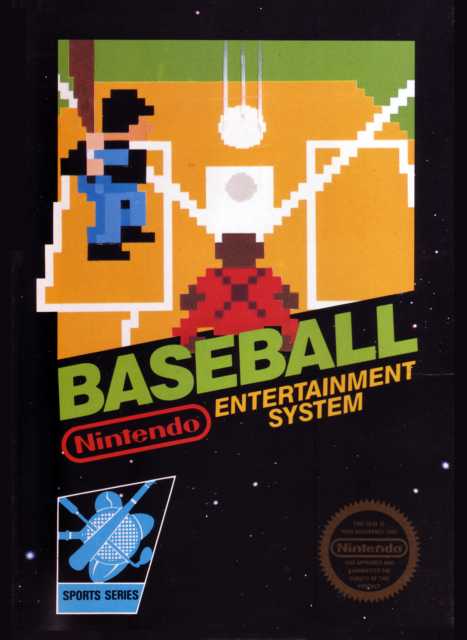
Log in to comment